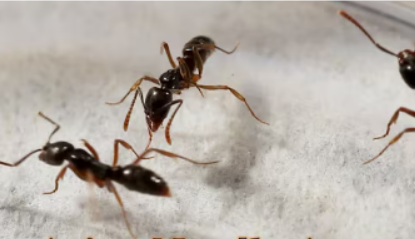An invasive insect is making its way through 19 US states—is your hometown in danger?
- Replies 0
If you thought red fire ants were the nastiest bugs you had to worry about, think again.
A new—and venomous—invader is rapidly spreading across the United States.
An invasive ant species, first seen in the US nearly a century ago, is now rapidly spreading and raising public health concerns.
Experts say its sting can cause severe allergic reactions and, in rare cases, even death.
Don’t let their size fool you. Asian needle ants are only about 1/5 of an inch long, but their sting packs a punch—and their population is growing fast.
These insects have shiny, dark brown or black bodies, with lighter orange-brown coloring on their legs and the tips of their antennae.
These ants have shiny, dark brown or black bodies with contrasting orange-brown legs and antennae tips. Both workers and queens typically grow to about 1/5 of an inch in length.
They are commonly found nesting in moist, protected areas such as under logs, stones, or potted plants. Their distinct coloration and preferred habitats make them relatively easy to identify.
They’re not aggressive like wasps, but they will sting if provoked, and their venom can trigger serious medical emergencies—especially in those with insect sting allergies.
Asian needle ants, native to China, are now found in 19 US states and are considered a venomous invasive species.
Confirmed states include: Florida, Georgia, Alabama, Mississippi, Arkansas, Tennessee, North Carolina, South Carolina, Kentucky, Virginia, Ohio, Pennsylvania, Maryland, Connecticut, Rhode Island, Massachusetts, New York, Wisconsin, and Washington.
If you live in or near these states—especially during the warm months of spring through late summer—it’s time to stay alert.
Read also: Rising US-China tensions—what it means for you
For most people, a sting from an Asian needle ant causes hours of intense, pulsing pain. But for others, especially those allergic to insect venom, it can trigger anaphylaxis—a potentially deadly reaction that includes:
Asian needle ants thrive in damp, shaded environments such as under rocks, mulch, and rotting logs.
They are also commonly found inside potted plants, landscaping materials, wood piles, and bricks.
Occasionally, they make their way indoors, especially during spring’s swarming season.
These ants are highly adaptable and can live in both urban and rural areas, tolerating cooler climates—which makes their spread increasingly difficult to contain.
The danger isn’t just to people—these ants are wrecking ecosystems too.
Asian needle ants are displacing native ant species that help spread seeds and maintain forest biodiversity.
In areas they’ve invaded, researchers have recorded sharp declines in native ant populations and seed dispersal rates.
In short: these ants are disrupting the natural balance, potentially altering forests and local food chains in the long run.
Read next: New twist: China just made a surprising claim about where COVID-19 really came from!

Have you spotted Asian needle ants in your area? Have you or someone you know experienced a sting? What precautions are you taking to protect your home and garden?
A new—and venomous—invader is rapidly spreading across the United States.
An invasive ant species, first seen in the US nearly a century ago, is now rapidly spreading and raising public health concerns.
Experts say its sting can cause severe allergic reactions and, in rare cases, even death.
Don’t let their size fool you. Asian needle ants are only about 1/5 of an inch long, but their sting packs a punch—and their population is growing fast.
These insects have shiny, dark brown or black bodies, with lighter orange-brown coloring on their legs and the tips of their antennae.
These ants have shiny, dark brown or black bodies with contrasting orange-brown legs and antennae tips. Both workers and queens typically grow to about 1/5 of an inch in length.
They are commonly found nesting in moist, protected areas such as under logs, stones, or potted plants. Their distinct coloration and preferred habitats make them relatively easy to identify.
They’re not aggressive like wasps, but they will sting if provoked, and their venom can trigger serious medical emergencies—especially in those with insect sting allergies.
Asian needle ants, native to China, are now found in 19 US states and are considered a venomous invasive species.
Confirmed states include: Florida, Georgia, Alabama, Mississippi, Arkansas, Tennessee, North Carolina, South Carolina, Kentucky, Virginia, Ohio, Pennsylvania, Maryland, Connecticut, Rhode Island, Massachusetts, New York, Wisconsin, and Washington.
If you live in or near these states—especially during the warm months of spring through late summer—it’s time to stay alert.
Read also: Rising US-China tensions—what it means for you
For most people, a sting from an Asian needle ant causes hours of intense, pulsing pain. But for others, especially those allergic to insect venom, it can trigger anaphylaxis—a potentially deadly reaction that includes:
- Swelling of the tongue or throat
- Trouble breathing
- Nausea or vomiting
- Dizziness or fainting
- Skin hives or a rash
- A sense of “impending doom”
Asian needle ants thrive in damp, shaded environments such as under rocks, mulch, and rotting logs.
They are also commonly found inside potted plants, landscaping materials, wood piles, and bricks.
Occasionally, they make their way indoors, especially during spring’s swarming season.
These ants are highly adaptable and can live in both urban and rural areas, tolerating cooler climates—which makes their spread increasingly difficult to contain.
The danger isn’t just to people—these ants are wrecking ecosystems too.
Asian needle ants are displacing native ant species that help spread seeds and maintain forest biodiversity.
In areas they’ve invaded, researchers have recorded sharp declines in native ant populations and seed dispersal rates.
In short: these ants are disrupting the natural balance, potentially altering forests and local food chains in the long run.
Read next: New twist: China just made a surprising claim about where COVID-19 really came from!
Key Takeaways
- Asian needle ants, native to China, are now found in 19 US states and are considered a venomous invasive species.
- Their stings can cause intense pain and, in some cases, severe allergic reactions including anaphylaxis.
- Scientists are concerned about their impact on native ant species, seed dispersal, and broader forest ecosystems.
- Residents are encouraged to report sightings, take preventive measures, and stay informed as the ants spread across more regions.







